|
|
|
| HOME | STUDIES | PROBLEMS | GAMES | PLAY CHESS | TOURNAMENTS |

|
Let's begin to learn chess: |
|
| Chess pieces
|
|
 Initial position |
|
| Checkmate : The main goal of chess is to checkmate your opponent's King. If it is impossible for you to move your King to any square , to place another piece between King and the attacker or to capture the attacking piece when your King is threatened with capture, this means that you are checkmated and you lose the game. | 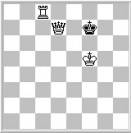 |
| The King : If your King is captured , you lose the game. The King can move one square in any direction , ( See diagram ) . See also castling It is forbidden to move onto a square controlled by an opponent's piece. |  |
| The Queen : The Queen can move any number of squares horizontally, vertically, or diagonally .( See diagram ) Its move can be blocked if a piece is on its path. It can't jump over the pieces. |  |
| The Rook : The Rook can move any number of squares vertically or horizontally .( See diagram ) Its move can be blocked if a piece is on its path. It can't jump over the pieces. | 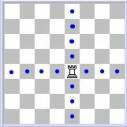 |
| The Bishop : The Bishop can move any number of squares diagonally .( See diagram ) Its move can be blocked if a piece is on its path. It can't jump over the pieces. |  |
| The Knight : The Knight's move is as a letter "L" .( See diagram ) 1- It moves two squares horizontally and one square ahead or backward 2- It moves two squares vertically and one square left or right. Only the Knight can jump over other pieces. | 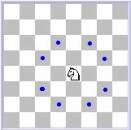 |
| The Pawn : The pawn always moves only forward ( See diagram "move" ), but it captures diagonally. It moves one square , but if it is its first move it has the option of moving forward one or two squares. ( See diagram "capture") |
  move --- capture |
|
Pawn promotion : If a pawn reaches the end of a file which is at the opponent side , it is immediately "promoted" to another piece, Queen, Rook, Knight or Bishop but not to pawn or King . |
pawn is promoting to Queen |
|
En Passant: If a pawn moves two squares and it comes next to the pawn of its opponent It is pretended that it moved one square and it can be captured by this pawn. ( See diagram ) .But this option can be used only after the pawn moves two squares. For example ( See diagram ) if white pawn doesn't capture the black pawn now it will loose "en passant right" and will not have the right to capture this black pawn during the game. |
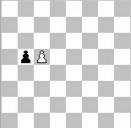 before en passant  after en passant |
| Special moves (Castling): Castling is a special move . You can move the King and the Rook at once. King moves two squares to right or left and Rook is placed beside it. 2 kinds of castling is possible short castling ( See diagram a-1 ) and long castling ( See diagram a-2 ). Castling is not allowed if the King and the Rook involved have moved, if there is any piece between the King and the Rook involved , if the King is attacked by opponent's piece and if the King cross or move on a square controlled by opponent's piece . |
 a - before short castling  a1 - after short castling a2 - after long castling |
| Stalemate : Despite the fact that a King is not in check, if you can make no legal move, the position is called a stalemate so the game is scored as a draw.(See diagram) Black has to make a move but no legal move is possible for him. | 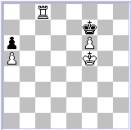 |